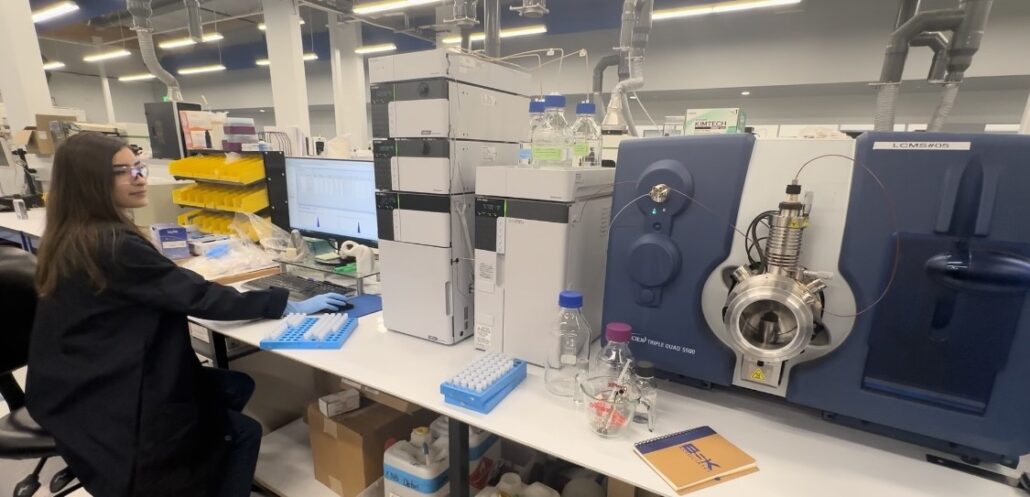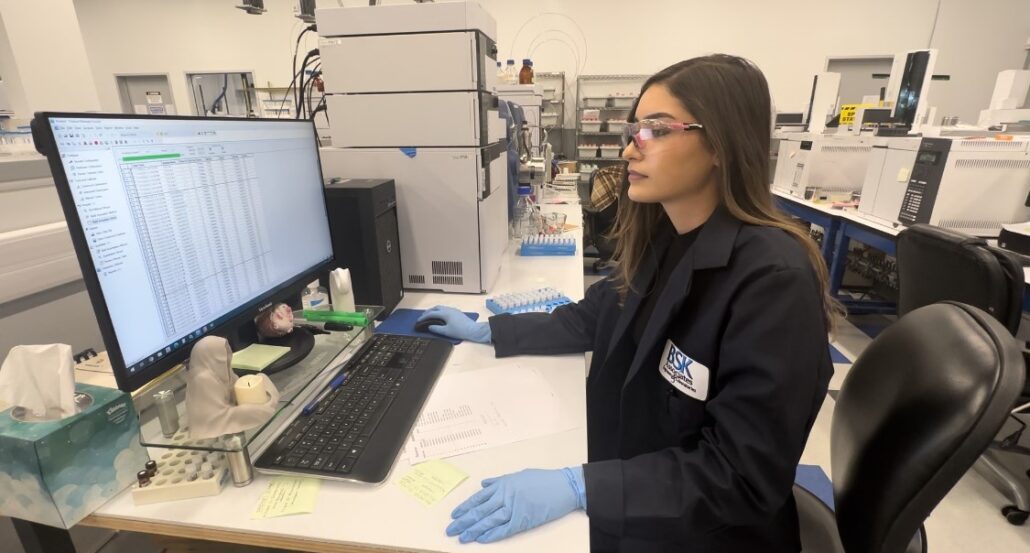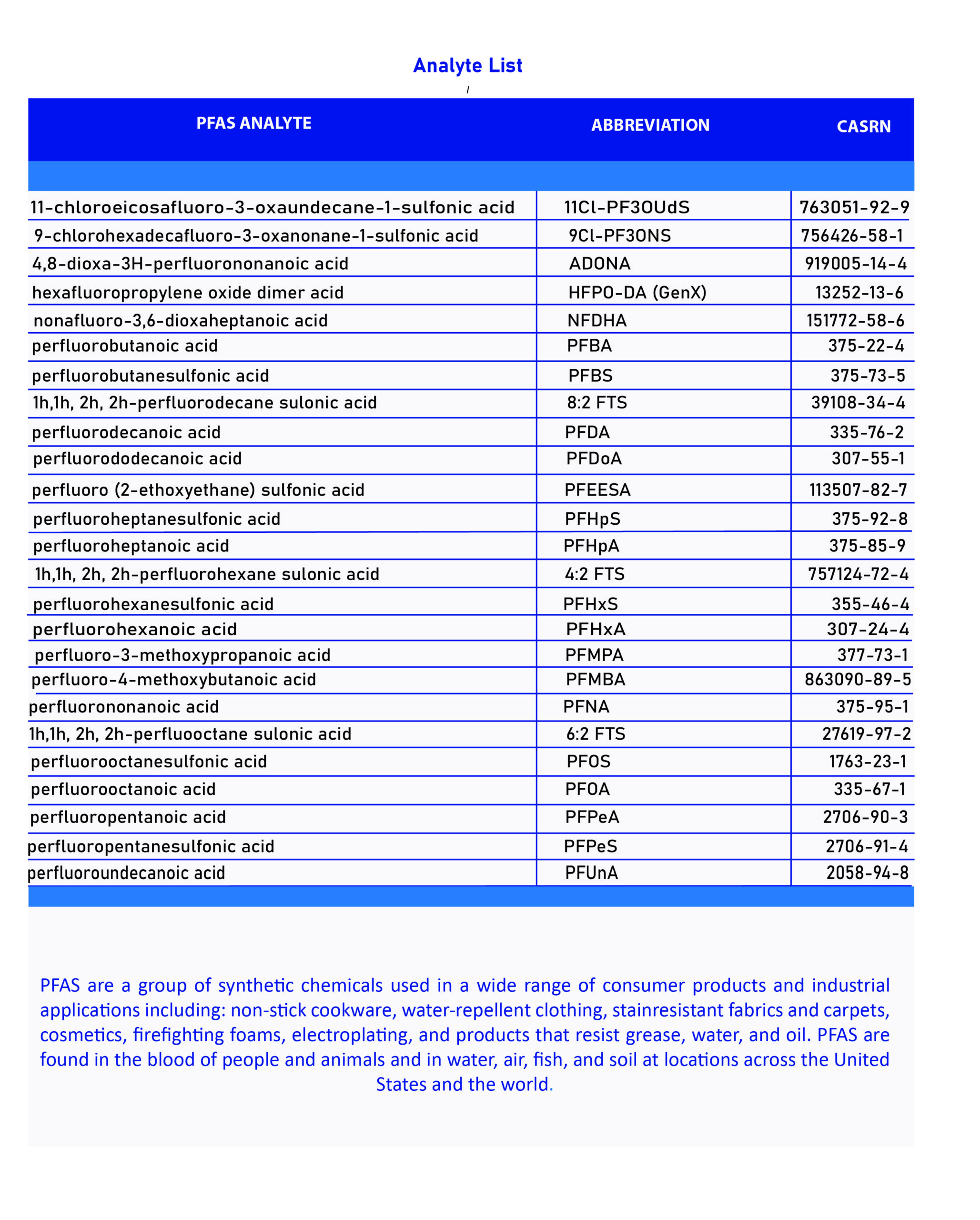PFAS Testing
BSK Your Trusted Partner for Precise Water Testing.
Do you know how important it is to find these forever chemicals?
In the complex web of environmental concerns, one issue that has risen to the forefront is the presence of per- and polyfluoroalkyl substances, or PFAS. These “forever chemicals,” as they are commonly known, have quietly seeped into our surroundings, raising red flags about their potential impact on both the environment and human health. In this article, we’ll delve into why identifying PFAS in water testing is so important and how accurate analysis, like that offered by BSK Associates, plays a pivotal role.
Unveiling the Forever Chemical
PFAS substances make up a group of human-made chemicals characterized by their strong carbon-fluorine bonds. They have been utilized in a variety of industrial applications due to their resistance to heat, water, and oil. This quality made them valuable in countless products, from non-stick cookware to waterproof goods. However, this very stability is what makes them persistent and capable of piling up in the environment, including our water sources.
Water, the lifeblood of our planet, has become a carrier of PFAS contamination. These chemicals can seep into groundwater from industrial sites, landfills, and even firefighting foam use. As a result, they find their way into drinking water sources. This increases the risk of exposing communities to their harmful effects.

Why Finding PFAS in Water Testing Matters
One of the biggest concerns is that of human health. The presence of PFAS in drinking water raises many health concerns. Studies have linked long-term exposure to harmful health effects. These include but are not limited to developmental issues, immune system disruption, liver damage, metabolism issues, and even an increased risk of certain cancers. As time goes on our scientists are finding more data that show these adverse health effects are just scratching the surface. By identifying PFAS in water sources, we can take measures to mitigate these risks. Subsequentially keeping our communities safe.
PFAS contamination not only affects human health but also has the potential to harm aquatic ecosystems. These chemicals can disrupt the balance of aquatic life and negatively impact sensitive species. By pinpointing sources of PFAS contamination through accurate water testing, we can safeguard the delicate balance of our ecosystems.
The BSK Difference
Accurate water testing is essential when it comes to identifying PFAS contamination. BSK Associates, with its analytical talents stand at the forefront of providing precise analysis. Additionally, our commitment to accuracy ensures that contamination is identified reliably and quickly. Knowledge is power, and with accurate PFAS water testing you can make informed decisions about your water sources.
BSK Associates was one of the first labs to become certified for Per- and Polyfluoroalkyl Substances, (PFAS). PFAS testing in the state of California. As a leader in PFAS testing our technical experts are here to assist you with your PFAS projects. We follow strict Quality Assurance / Quality Control guidelines. We are accredited by the National Environmental Laboratory Accreditation Program, (NELAP) and the California Environmental Laboratory Accreditation Program, (CA ELAP) for all PFAS compounds in drinking water by EPA’s 533 and 537.1 methodologies.
Our laboratory has performed PFAS analyses for more than 10 years now. During that time, our laboratory has analyzed thousands of EPA method 537 samples while participating in EPA’s UCMR3 monitoring program as well as drinking water by EPA method 537.1.
Furthermore, our commitment to excellence goes hand in hand with our investment in our new state-of-the-art lab. With our cutting-edge laboratory equipment, can deliver unparalleled accuracy, reliability, and innovation in our services.
The significance of detecting PFAS in water testing cannot be overstated. As we navigate this complex issue, it becomes clear that safeguarding our water resources is a shared responsibility. With accurate analysis from experts like BSK, we can take proactive steps towards mitigating the impact of PFAS contamination. Together, we can ensure that our water remains pure and safe.

PFAS LEGISLATION
National Laws & Regulations (U.S. EPA)
- National Laws & Regulations / US EPA
- U.S. EPA Proposes Drinking Water Regulations for PFAS (wef.org)
- Key EPA Actions to Address PFAS | US EPA
- Previous Actions to Address PFAS | US EPA
- FACT SHEET: Biden-Harris Administration Takes New Action to Protect Communities from PFAS Pollution | The White House
Washington (WA)
PFAS Analyte List, Common Abbreviations, and CASRN

Keywords and Definitions
- Perfluorinated Chemicals (PFCs):
- Perfluorinated chemicals, often called PFCs, form a group of synthetic compounds renowned for their exceptional resistance to water and oil. They find applications in a wide range of industrial and consumer products.
- Perfluorochemicals (PFCs):
- Perfluorochemicals, or PFCs, are synthetic substances with distinctive properties, including water and grease repellency. They are commonly used in non-stick cookware, waterproof textiles, and more.
- Perfluoroalkyls:
- Perfluoroalkyls are a subset of perfluorinated chemicals characterized by their fully fluorinated carbon chains. They are utilized in products such as stain-resistant fabrics and firefighting foam.
- Perfluorinated Alkyl Acids:
- Perfluorinated alkyl acids are specific perfluorinated compounds known for their stability and low surface tension. They can be found in items like surface protectants and industrial applications.
- Polyfluorinated Chemicals (PFAS):
- Polyfluorinated chemicals, also known as PFAS, constitute a family of synthetic compounds recognized for their resistance to water and oil. They serve various purposes, including non-stick coatings.
- Polyfluorinated Compounds (PFAS):
- Polyfluorinated compounds, or PFAS, comprise a group of synthetic substances celebrated for their water and oil repellent properties. They are prevalent in everyday items like non-stick pans and stain-resistant fabrics.
- Polyfluoroalkyl Substances (PFAS):
- Polyfluoroalkyl substances, or PFAS, represent a family of synthetic compounds known for their durability and unique chemical structure. They are extensively used in numerous industrial and consumer products due to their repellent properties.
- C8:
- C8 is a common reference to longer-chain PFAS compounds with eight carbon atoms.
- Teflon Chemicals:
- Some PFAS compounds are utilized in the production of Teflon, a well-known nonstick coating.
- Perfluorooctanoic Acid (PFOA):
- Also known as C8, PFOA is a synthetic compound known for its water and grease-resistant properties. It is commonly used in non-stick cookware, waterproof clothing, and stain-resistant fabrics.
- Perfluorooctanesulfonic Acid (PFOS):
- PFOS is a synthetic chemical predominantly used in firefighting foams, surface protectants, and various industrial applications.
- Perfluorohexane Sulfonic Acid (PFHxS):
- PFHxS is employed in industrial processes and consumer goods, including firefighting foams.
- Perfluorononanoic Acid (PFNA):
- PFNA is recognized for its water and oil-repellent properties in various products. It is present in industrial processes and consumer goods.
- Perfluorodecanoic Acid (PFDA):
- PFDA is found in various product manufacturing processes, including the production of surfactants.
- Perfluoropentanoic Acid (PFPeA):
- PFPeA is utilized in specific industrial processes.
- Perfluorohexanoic Acid (PFHxA):
- PFHxA is found in industrial processes and consumer products.
- Perfluorobutanesulfonic Acid (PFBS):
- PFBS is used in polymer production and consumer goods.
Corporate Headquarters
Fresno, CA 93727
Local: (559) 497-2880
Toll-Free: (800) 669-3201
Hours of Operation
Individual Office Hours May Vary
Click Here to Find A Location Near You

